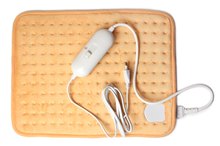Tightness in the Heel Cord & Hamstring
Tightness in your hamstrings and your heel cord — or Achilles tendon — can cause major discomfort when you move. Since these two parts are connected by nerves and fascia, the tightness sensation in one area — such as the heel cord — can affect how tight your hamstrings feel and vice versa. Tightness in these areas can be caused by a number of factors, so explore different ways to alleviate the discomfort in the hamstring and heel cord.
Inflammation
Whether you suffered a hamstring or heel cord injury last year or finished a half-marathon yesterday, you may feel soreness in your hamstrings and lower calves. The soreness stems from inflammation in your muscles and connective tissues that can cause your hamstrings and heel cords to tighten.
This is a protective behavior that your nervous system induces to protect your muscles and joints from tearing, says massage therapist Todd Hargrove. Although it's tempting to stretch your tight and sore hamstrings and heel cords, stretching can cause a stretch reflex that causes your muscles and tissues to contract involuntarily to protect themselves from tearing. As a result, your hamstrings and heel cords may end up feeling tighter and less responsive to relaxation.
Read more: How to Treat a Sore Achilles Tendon
- Whether you suffered a hamstring or heel cord injury last year or finished a half-marathon yesterday, you may feel soreness in your hamstrings and lower calves.
- Although it's tempting to stretch your tight and sore hamstrings and heel cords, stretching can cause a stretch reflex that causes your muscles and tissues to contract involuntarily to protect themselves from tearing.
Perception Can Be Tricky
How to Relieve Sciatic Pain in the Pelvic & Hip Joints
Learn More
Sometimes the length of your hamstrings and heel cords are normal, but your brain perceives them to be tight. Although it's not yet known why your nervous system behaves this way, exercise scientists proposed a sensory theory to explain the behavior.
A study published in the March 2010 issue of Physical Therapy stated that subjects who completed a three- to eight-week stretching program had a modified sensation in their flexibility rather than actual changes to the length of their muscles.
Therefore, the tightness sensation may be just in your head rather than the actual shortening of your hamstrings and heel cords. So, if you feel like stretching is working to loosen up your tight areas -- proceed!
- Sometimes the length of your hamstrings and heel cords are normal, but your brain perceives them to be tight.
- Therefore, the tightness sensation may be just in your head rather than the actual shortening of your hamstrings and heel cords.
Self-Myofascial Release
Self-myofascial release, or SMR, is a type of self-massage that's used to enhance muscle and connective tissue relaxation. By applying gentle pressure upon the muscle belly or near the muscle attachments with a foam roller, a sensory organ called the Golgi tendon organ is activated, which stimulates the muscle fibers and tissues to lengthen.
The National Academy of Sports Medicine recommends that you maintain the compression for 20 to 30 seconds, but the duration can be longer if the tenderness doesn't subside. Since the heel cord can be very tender to pressure, apply pressure to the lower calf instead.
Read more: Hamstring Strengthening Exercises at Home
- Self-myofascial release, or SMR, is a type of self-massage that's used to enhance muscle and connective tissue relaxation.
Get Dynamic
A Knot in My Hamstring After a Pull
Learn More
Static stretching, which is holding a stretch for 20 to 30 seconds, may decrease the tightness in your hamstrings and heel cords, but it does little in improving your athletic performance.
Dynamic flexibility, which involves moving your joints and muscles repetitively within your full range of motion, should be performed before any workout instead of static stretching.
In a study published in the April 2012 issue of "Journal of Strength and Conditioning Research," researchers at the University of North Carolina at Chapel Hill found that subjects who performed a dynamic warm-up before performing strength and flexibility tests had a higher improvement in strength and flexibility than those who did standard stretching or no stretching.
The latter two groups had no positive or negative changes in strength or flexibility. Sample exercises that work your hamstrings and heel cords together include leg swings, walking lunges, jogging butt kicks and lateral skipping.
- Static stretching, which is holding a stretch for 20 to 30 seconds, may decrease the tightness in your hamstrings and heel cords, but it does little in improving your athletic performance.
- Dynamic flexibility, which involves moving your joints and muscles repetitively within your full range of motion, should be performed before any workout instead of static stretching.
Related Articles
References
- Anatomy Trains; Thomas Myers
- Better Movement: Should You Stretch a Sore Muscle?
- Physical Therapy: Increasing Muscle Extensibility: A Matter of Increasing Length or Modifying Sensation?
- NASM Essentials of Personal Fitness Training; Michael Clark
- Foot and Ankle International: Influence of Stretching and Warm-Up on Achilles Tendon Material Properties
- Journal of Strength and Conditioning Research: A Dynamic Warm-Up Model Increases Quadriceps Strength and Hamstring Flexibility
- American Academy of Orthopedic Surgeons. (2017). Heel Pain. https://orthoinfo.aaos.org/en/diseases--conditions/heel-pain
- Tu P, Bytomski JR. Diagnosis of Heel Pain. Am Fam Physician. 2011 Oct 15;84(8):909-16. https://www.aafp.org/afp/2011/1015/p909.html
- Tu P, Bytomski JR. Diagnosis of heel pain. Am Fam Physician. 2011;84(8):909-16.
- Lim AT, How CH, Tan B. Management of plantar fasciitis in the outpatient setting. Singapore Med J. 2016;57(4):168-70. doi:10.11622/smedj.2016069
- Li HY, Hua YH. Achilles Tendinopathy: Current Concepts about the Basic Science and Clinical Treatments. Biomed Res Int. 2016;2016:6492597. doi:10.1155/2016/6492597
- Gulati V, Jaggard M, Al-nammari SS, et al. Management of achilles tendon injury: A current concepts systematic review. World J Orthop. 2015;6(4):380-6. doi:10.5312/wjo.v6.i4.380
- Hong CH, Lee YK, Won SH, Lee DW, Moon SI, Kim WJ. Tarsal tunnel syndrome caused by an uncommon ossicle of the talus: A case report. Medicine (Baltimore). 2018;97(25):e11008. doi:10.1097/MD.0000000000011008
- Mayer SW, Joyner PW, Almekinders LC, Parekh SG. Stress fractures of the foot and ankle in athletes. Sports Health. 2014;6(6):481-91. doi:10.1177/1941738113486588
- Tu P. Heel Pain: Diagnosis and Management. Am Fam Physician. 2018;97(2):86-93.
- Yi TI, Lee GE, Seo IS, Huh WS, Yoon TH, Kim BR. Clinical characteristics of the causes of plantar heel pain. Ann Rehabil Med. 2011;35(4):507-13. doi:10.5535/arm.2011.35.4.507
- Kucuksen S, Karahan AY, Erol K. Haglund syndrome with pump bump. Med Arch. 2012;66(6):425-7.
- Vaishya R, Agarwal AK, Azizi AT, Vijay V. Haglund's Syndrome: A Commonly Seen Mysterious Condition. Cureus. 2016;8(10):e820. doi:10.7759/cureus.820
- Pękala PA, Henry BM, Pękala JR, Piska K, Tomaszewski KA. The Achilles tendon and the retrocalcaneal bursa: An anatomical and radiological study. Bone Joint Res. 2017;6(7):446-451. doi:10.1302/2046-3758.67.BJR-2016-0340.R1
- Helgeson K. Examination and intervention for sinus tarsi syndrome. N Am J Sports Phys Ther. 2009;4(1):29-37.
- Ma DL, Vano-galvan S. Piezogenic pedal papules. CMAJ. 2013;185(18):E847. doi:10.1503/cmaj.121963
- Fritz JM, Mcdonald JR. Osteomyelitis: approach to diagnosis and treatment. Phys Sportsmed. 2008;36(1):nihpa116823. doi:10.3810/psm.2008.12.11
- Yan L, Zong J, Chu J, et al. Primary tumours of the calcaneus. Oncol Lett. 2018;15(6):8901-8914. doi:10.3892/ol.2018.8487
- Narváez JA, Narváez J, Ortega R, Aguilera C, Sánchez A, Andía E. Painful heel: MR imaging findings. Radiographics. 2000;20(2):333-52. doi:10.1148/radiographics.20.2.g00mc09333
- Thomas JL, Christensen JC, Kravitz SR, et al. The diagnosis and treatment of heel pain: a clinical practice guideline-revision 2010. J Foot Ankle Surg. 2010;49(3 Suppl):S1-19. doi:10.1053/j.jfas.2010.01.001
- Noor S, Khan RU, Ahmad J. Understanding Diabetic Foot Infection and its Management. Diabetes Metab Syndr. 2017;11(2):149-156. doi:10.1016/j.dsx.2016.06.023
- Lui E. Systemic causes of heel pain. Clin Podiatr Med Surg. 2010;27(3):431-41. doi:10.1016/j.cpm.2010.04.004
- Podolsky R, Kalichman L. Taping for plantar fasciitis. J Back Musculoskelet Rehabil. 2015;28(1):1-6. doi:10.3233/BMR-140485
- Habets B, Van cingel REH, Backx FJG, Huisstede BMA. Alfredson versus Silbernagel exercise therapy in chronic midportion Achilles tendinopathy: study protocol for a randomized controlled trial. BMC Musculoskelet Disord. 2017;18(1):296. doi:10.1186/s12891-017-1656-4
- Riskowski J, Dufour AB, Hannan MT. Arthritis, foot pain and shoe wear: current musculoskeletal research on feet. Curr Opin Rheumatol. 2011;23(2):148-55. doi:10.1097/BOR.0b013e3283422cf5
- Donley BG, Moore T, Sferra J, Gozdanovic J, Smith R. The efficacy of oral nonsteroidal anti-inflammatory medication (NSAID) in the treatment of plantar fasciitis: a randomized, prospective, placebo-controlled study. Foot Ankle Int. 2007;28(1):20-3. doi:10.3113/FAI.2007.0004
- Sahu RL. Percutaneous planter fasciitis release under local anesthesia: A prospective study. Chin J Traumatol. 2017;20(2):87-89. doi:10.1016/j.cjtee.2017.01.002
- American Academy of Orthopedic Surgeons. (2017). Heel Pain.
- Buchbinder R. (2018). Patient education: Heel and foot pain (caused by plantar fasciitis) (Beyond the Basics). Isaac Z, ed. UpToDate. Waltham, MA: UpToDate Inc.
- Lareau CR, Sawyer G, Wang JH, DiGiovanni CW. Plantar and medial heel pain: diagnosis and management. J Am Acad Orthop Surg. 2014 Jun;22(6):372-80. doi: 10.5435/JAAOS-22-06-372
- Ma DL, Vano-Galvan S. Piezogenic pedal papules. CMAJ. 2013 Dec 10;185(18):E847. doi: 10.1503/cmaj.121963
- Tu P, Bytomski JR. Diagnosis of Heel Pain. Am Fam Physician. 2011 Oct 15;84(8):909-16.
- Vaishya R, Agarwal AK, Azizi AT, Vijay V. Haglund's Syndrome: A Commonly Seen Mysterious Condition. Cureus. 2016 Oct;8(10):e820. doi: 10.7759/cureus.820
Writer Bio
Nick Ng has been writing fitness articles since 2003, focusing on injury prevention and exercise strategies. He has covered health for "MiaBella" magazine. Ng received his Bachelor of Arts in communications from San Diego State University in 2001 and has been a certified fitness coach with the National Academy of Sports Medicine since 2002.





